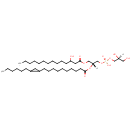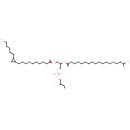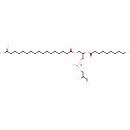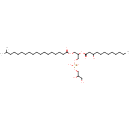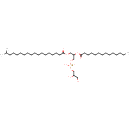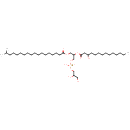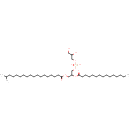
Search Results for compounds
Searching compounds for
returned 4373 results.
Displaying compounds 2271 - 2280 of
4373 in total
PG(19:0cycv8c/14:0(3-OH)) (PAMDB004101)
IUPAC:
[(2S)-2,3-dihydroxypropoxy][(2R)-2-{[10-(2-hexylcyclopropyl)decanoyl]oxy}-3-[(3-hydroxytetradecanoyl)oxy]propoxy]phosphinic acid
CAS: Not Available
Description: PG(19:0cycv8c/14:0(3-OH)) is a phosphatidylglycerol. Phosphatidylglycerols consist of a glycerol 3-phosphate backbone esterified to either saturated or unsaturated fatty acids on carbons 1 and 2. As is the case with diacylglycerols, phosphatidylglycerols can have many different combinations of fatty acids of varying lengths and saturation attached to the C-1 and C-2 positions. PG(19:0cycv8c/14:0(3-OH)), in particular, consists of one heptadec-11-12-cyclo-anoyl chain to the C-1 atom, and one 3-hydroxytetradecanoyl to the C-2 atom. In Pseudomonas aeruginosa glycerophospholipid metabolism, phosphatidylglycerol is formed from phosphatidic acid (1,2-diacyl-sn-glycerol 3-phosphate) by a sequence of enzymatic reactions that proceeds via two intermediates, cytidine diphosphate diacylglycerol (CDP-diacylglycerol) and phosphatidylglycerophosphate (PGP, a phosphorylated phosphatidylglycerol). Phosphatidylglycerols, along with CDP-diacylglycerol, also serve as precursor molecules for the synthesis of cardiolipin, a phospholipid found in membranes.
PG(19:0cycv8c/19:iso) (PAMDB004102)
IUPAC:
(2,3-dihydroxypropoxy)(3-{[10-(2-hexylcyclopropyl)decanoyl]oxy}-2-[(17-methyloctadecanoyl)oxy]propoxy)phosphinic acid
CAS: Not Available
Description: PG(19:0cycv8c/19:iso) is a phosphatidylglycerol. Phosphatidylglycerols consist of a glycerol 3-phosphate backbone esterified to either saturated or unsaturated fatty acids on carbons 1 and 2. As is the case with diacylglycerols, phosphatidylglycerols can have many different combinations of fatty acids of varying lengths and saturation attached to the C-1 and C-2 positions. PG(19:0cycv8c/19:iso), in particular, consists of one heptadec-11-12-cyclo-anoyl chain to the C-1 atom, and one 17-methylocatdecanoyl to the C-2 atom. In Pseudomonas aeruginosa glycerophospholipid metabolism, phosphatidylglycerol is formed from phosphatidic acid (1,2-diacyl-sn-glycerol 3-phosphate) by a sequence of enzymatic reactions that proceeds via two intermediates, cytidine diphosphate diacylglycerol (CDP-diacylglycerol) and phosphatidylglycerophosphate (PGP, a phosphorylated phosphatidylglycerol). Phosphatidylglycerols, along with CDP-diacylglycerol, also serve as precursor molecules for the synthesis of cardiolipin, a phospholipid found in membranes.
PG(19:iso/10:0) (PAMDB004103)
IUPAC:
[2-(decanoyloxy)-3-[(17-methyloctadecanoyl)oxy]propoxy](2,3-dihydroxypropoxy)phosphinic acid
CAS: Not Available
Description: PG(19:iso/10:0) is a phosphatidylglycerol. Phosphatidylglycerols consist of a glycerol 3-phosphate backbone esterified to either saturated or unsaturated fatty acids on carbons 1 and 2. As is the case with diacylglycerols, phosphatidylglycerols can have many different combinations of fatty acids of varying lengths and saturation attached to the C-1 and C-2 positions. PG(19:iso/10:0), in particular, consists of one 17-methylocatdecanoyl chain to the C-1 atom, and one decanoyl to the C-2 atom. In Pseudomonas aeruginosa glycerophospholipid metabolism, phosphatidylglycerol is formed from phosphatidic acid (1,2-diacyl-sn-glycerol 3-phosphate) by a sequence of enzymatic reactions that proceeds via two intermediates, cytidine diphosphate diacylglycerol (CDP-diacylglycerol) and phosphatidylglycerophosphate (PGP, a phosphorylated phosphatidylglycerol). Phosphatidylglycerols, along with CDP-diacylglycerol, also serve as precursor molecules for the synthesis of cardiolipin, a phospholipid found in membranes.
PG(19:iso/10:0(3-OH)) (PAMDB004104)
IUPAC:
(2,3-dihydroxypropoxy)({2-[(3-hydroxydecanoyl)oxy]-3-[(17-methyloctadecanoyl)oxy]propoxy})phosphinic acid
CAS: Not Available
Description: PG(19:iso/10:0(3-OH)) is a phosphatidylglycerol. Phosphatidylglycerols consist of a glycerol 3-phosphate backbone esterified to either saturated or unsaturated fatty acids on carbons 1 and 2. As is the case with diacylglycerols, phosphatidylglycerols can have many different combinations of fatty acids of varying lengths and saturation attached to the C-1 and C-2 positions. PG(19:iso/10:0(3-OH)), in particular, consists of one 17-methylocatdecanoyl chain to the C-1 atom, and one 3-hydroxydecanoyl to the C-2 atom. In Pseudomonas aeruginosa glycerophospholipid metabolism, phosphatidylglycerol is formed from phosphatidic acid (1,2-diacyl-sn-glycerol 3-phosphate) by a sequence of enzymatic reactions that proceeds via two intermediates, cytidine diphosphate diacylglycerol (CDP-diacylglycerol) and phosphatidylglycerophosphate (PGP, a phosphorylated phosphatidylglycerol). Phosphatidylglycerols, along with CDP-diacylglycerol, also serve as precursor molecules for the synthesis of cardiolipin, a phospholipid found in membranes.
PG(19:iso/12:0) (PAMDB004105)
IUPAC:
(2,3-dihydroxypropoxy)[2-(dodecanoyloxy)-3-[(17-methyloctadecanoyl)oxy]propoxy]phosphinic acid
CAS: Not Available
Description: PG(19:iso/12:0) is a phosphatidylglycerol. Phosphatidylglycerols consist of a glycerol 3-phosphate backbone esterified to either saturated or unsaturated fatty acids on carbons 1 and 2. As is the case with diacylglycerols, phosphatidylglycerols can have many different combinations of fatty acids of varying lengths and saturation attached to the C-1 and C-2 positions. PG(19:iso/12:0), in particular, consists of one 17-methylocatdecanoyl chain to the C-1 atom, and one dodecanoyl to the C-2 atom. In Pseudomonas aeruginosa glycerophospholipid metabolism, phosphatidylglycerol is formed from phosphatidic acid (1,2-diacyl-sn-glycerol 3-phosphate) by a sequence of enzymatic reactions that proceeds via two intermediates, cytidine diphosphate diacylglycerol (CDP-diacylglycerol) and phosphatidylglycerophosphate (PGP, a phosphorylated phosphatidylglycerol). Phosphatidylglycerols, along with CDP-diacylglycerol, also serve as precursor molecules for the synthesis of cardiolipin, a phospholipid found in membranes.
PG(19:iso/12:0(3-OH)) (PAMDB004106)
IUPAC:
(2,3-dihydroxypropoxy)({2-[(3-hydroxydodecanoyl)oxy]-3-[(17-methyloctadecanoyl)oxy]propoxy})phosphinic acid
CAS: Not Available
Description: PG(19:iso/12:0(3-OH)) is a phosphatidylglycerol. Phosphatidylglycerols consist of a glycerol 3-phosphate backbone esterified to either saturated or unsaturated fatty acids on carbons 1 and 2. As is the case with diacylglycerols, phosphatidylglycerols can have many different combinations of fatty acids of varying lengths and saturation attached to the C-1 and C-2 positions. PG(19:iso/12:0(3-OH)), in particular, consists of one 17-methylocatdecanoyl chain to the C-1 atom, and one 3-hydroxydodecanoyl to the C-2 atom. In Pseudomonas aeruginosa glycerophospholipid metabolism, phosphatidylglycerol is formed from phosphatidic acid (1,2-diacyl-sn-glycerol 3-phosphate) by a sequence of enzymatic reactions that proceeds via two intermediates, cytidine diphosphate diacylglycerol (CDP-diacylglycerol) and phosphatidylglycerophosphate (PGP, a phosphorylated phosphatidylglycerol). Phosphatidylglycerols, along with CDP-diacylglycerol, also serve as precursor molecules for the synthesis of cardiolipin, a phospholipid found in membranes.
PG(19:iso/14:0) (PAMDB004107)
IUPAC:
(2,3-dihydroxypropoxy)({3-[(17-methyloctadecanoyl)oxy]-2-(tetradecanoyloxy)propoxy})phosphinic acid
CAS: Not Available
Description: PG(19:iso/14:0) is a phosphatidylglycerol. Phosphatidylglycerols consist of a glycerol 3-phosphate backbone esterified to either saturated or unsaturated fatty acids on carbons 1 and 2. As is the case with diacylglycerols, phosphatidylglycerols can have many different combinations of fatty acids of varying lengths and saturation attached to the C-1 and C-2 positions. PG(19:iso/14:0), in particular, consists of one 17-methylocatdecanoyl chain to the C-1 atom, and one tetradecanoyl to the C-2 atom. In Pseudomonas aeruginosa glycerophospholipid metabolism, phosphatidylglycerol is formed from phosphatidic acid (1,2-diacyl-sn-glycerol 3-phosphate) by a sequence of enzymatic reactions that proceeds via two intermediates, cytidine diphosphate diacylglycerol (CDP-diacylglycerol) and phosphatidylglycerophosphate (PGP, a phosphorylated phosphatidylglycerol). Phosphatidylglycerols, along with CDP-diacylglycerol, also serve as precursor molecules for the synthesis of cardiolipin, a phospholipid found in membranes.
PG(19:iso/14:0(3-OH)) (PAMDB004108)
IUPAC:
(2,3-dihydroxypropoxy)({2-[(3-hydroxytetradecanoyl)oxy]-3-[(17-methyloctadecanoyl)oxy]propoxy})phosphinic acid
CAS: Not Available
Description: PG(19:iso/14:0(3-OH)) is a phosphatidylglycerol. Phosphatidylglycerols consist of a glycerol 3-phosphate backbone esterified to either saturated or unsaturated fatty acids on carbons 1 and 2. As is the case with diacylglycerols, phosphatidylglycerols can have many different combinations of fatty acids of varying lengths and saturation attached to the C-1 and C-2 positions. PG(19:iso/14:0(3-OH)), in particular, consists of one 17-methylocatdecanoyl chain to the C-1 atom, and one 3-hydroxytetradecanoyl to the C-2 atom. In Pseudomonas aeruginosa glycerophospholipid metabolism, phosphatidylglycerol is formed from phosphatidic acid (1,2-diacyl-sn-glycerol 3-phosphate) by a sequence of enzymatic reactions that proceeds via two intermediates, cytidine diphosphate diacylglycerol (CDP-diacylglycerol) and phosphatidylglycerophosphate (PGP, a phosphorylated phosphatidylglycerol). Phosphatidylglycerols, along with CDP-diacylglycerol, also serve as precursor molecules for the synthesis of cardiolipin, a phospholipid found in membranes.
PG(19:iso/15:0) (PAMDB004109)
IUPAC:
(2,3-dihydroxypropoxy)({3-[(17-methyloctadecanoyl)oxy]-2-(pentadecanoyloxy)propoxy})phosphinic acid
CAS: Not Available
Description: PG(19:iso/15:0) is a phosphatidylglycerol. Phosphatidylglycerols consist of a glycerol 3-phosphate backbone esterified to either saturated or unsaturated fatty acids on carbons 1 and 2. As is the case with diacylglycerols, phosphatidylglycerols can have many different combinations of fatty acids of varying lengths and saturation attached to the C-1 and C-2 positions. PG(19:iso/15:0), in particular, consists of one 17-methylocatdecanoyl chain to the C-1 atom, and one pentadecanoyl to the C-2 atom. In Pseudomonas aeruginosa glycerophospholipid metabolism, phosphatidylglycerol is formed from phosphatidic acid (1,2-diacyl-sn-glycerol 3-phosphate) by a sequence of enzymatic reactions that proceeds via two intermediates, cytidine diphosphate diacylglycerol (CDP-diacylglycerol) and phosphatidylglycerophosphate (PGP, a phosphorylated phosphatidylglycerol). Phosphatidylglycerols, along with CDP-diacylglycerol, also serve as precursor molecules for the synthesis of cardiolipin, a phospholipid found in membranes.
PG(19:iso/15:0cyclo) (PAMDB004110)
IUPAC:
(2-{[8-(2-butylcyclopropyl)octanoyl]oxy}-3-[(17-methyloctadecanoyl)oxy]propoxy)(2,3-dihydroxypropoxy)phosphinic acid
CAS: Not Available
Description: PG(19:iso/15:0cyclo) is a phosphatidylglycerol. Phosphatidylglycerols consist of a glycerol 3-phosphate backbone esterified to either saturated or unsaturated fatty acids on carbons 1 and 2. As is the case with diacylglycerols, phosphatidylglycerols can have many different combinations of fatty acids of varying lengths and saturation attached to the C-1 and C-2 positions. PG(19:iso/15:0cyclo), in particular, consists of one 17-methylocatdecanoyl chain to the C-1 atom, and one cis-9,10-Methylenetetradecanoic acid to the C-2 atom. In Pseudomonas aeruginosa glycerophospholipid metabolism, phosphatidylglycerol is formed from phosphatidic acid (1,2-diacyl-sn-glycerol 3-phosphate) by a sequence of enzymatic reactions that proceeds via two intermediates, cytidine diphosphate diacylglycerol (CDP-diacylglycerol) and phosphatidylglycerophosphate (PGP, a phosphorylated phosphatidylglycerol). Phosphatidylglycerols, along with CDP-diacylglycerol, also serve as precursor molecules for the synthesis of cardiolipin, a phospholipid found in membranes.
